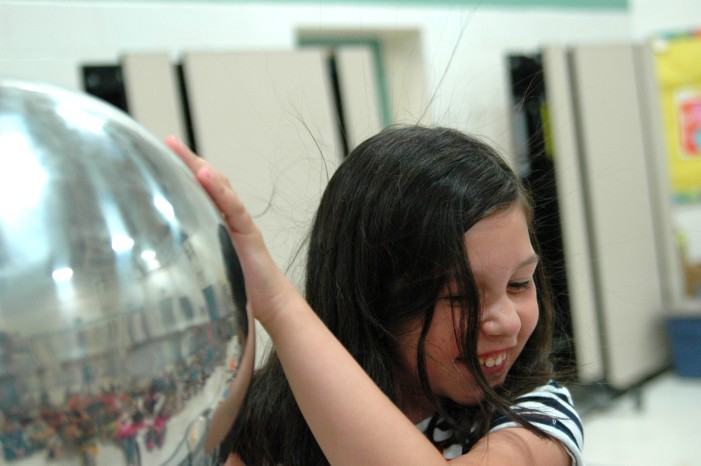By Meg Peters
Review Co-Editor
Firmly gripping the Van de Graaff generator, second grade student Rudy stood patiently as multiple strands of his hair charged and lifted.
Pine Tree Elementary second graders learned Monday the Van de Graaff is an electrostatic generator that produces static electricity, and sometimes a little shock after that static, or standing, electricity is released from its holder.
Rudy got that little shock as the room cheered. He was Kathy Finneran’s first “victim,” or “volunteer” as she jokingly corrected herself in front of the room of young scientists transfixed on her experiments.
Lake Orion resident Finneran is the Outreach Coordinator at the Cranbrook Institute of Science and brought the field trip with her to Pine Tree.
“Science on the Go” is the institute’s outreach program, and focuses on two topics: Matter and Energy, and Forces in Motion.
“A lot of times it’s a matter of helping the kids make a connection,” she said. “They are all tied into their electronics and ‘stuff’ but you start saying, ‘you know you are learning something when playing those video games. Why don’t you come see the real thing?’”
Finneran puts a spin on students’ everyday experiences using a scientific lens.
“When electricity is static, it will build up and cause that magnetic force that you see with magnets in your hair. If I were to turn this off, and you’re just standing there, that electricity will have no where to go, but it wants to go somewhere,” she told the three classrooms of students.
Just like the balloon, when rubbed vigorously on a hairy scalp ‘magnetizes to it,’ so does the Van de Graaff’s moving belt that accumulates the static electricity.
Finneran hit all the basic principles of science.
An abnormally large amount of silly putty slowly dripped off a table demonstrating the “invisible force” or law of gravity.
Newton’s Cradle, a device with five suspended metal balls, revealed Sir Isaac Newton’s first law of motion while explaining momentum and the law of inertia.
Finneran explained the states of matter with a chunk of amethyst, the ‘solid’, water, the ‘liquid,’ a balloon, the ‘gas’, and a plasma ball that depicted the fourth state of matter, “what our stars are made of.”
“I’m hoping that they see that science is fun. I want them to realize that they are all scientists, by simply making observations and asking questions,” she said.
One of her final experiments utilized two mini-scooters most elementary students have come to love during gym class.
Two more victims were chosen from the audience, George, who is tall and composed of a lot of matter, and Trey, who was much shorter and of less matter.
The two put their hands together and pushed. George did not move as Trey rolled away, demonstrating Newton’s third law of motion: for every action, there is an equal and opposite reaction.
When Trey’s twin brother Tommy was called to the front for the same experiment, weighing in at an almost equal mass, the twins moved apart in almost equal distances.
The Science on the Go program has been unleashed in a couple of elementary schools in Lake Orion, including Carpenter’s science nights program, and Blanche Sims.
Paint Creek Elementary students took an actual field trip to Cranbrook last week.
“I’m excited to hear that we’ve been invited out to the schools and they come use us as a resource as well,” Finneran said. “Sometimes you go to put a twist on it and get students interested in a different angle.”


Leave a Reply